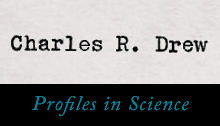Education
Higher Education Modules
Life after Death: Dr. Charles Drew, Civil Rights, and the Legacy of Race
Class 3: The Double Victory Campaign and Black War Participation
Introduction
The origins of the modern Civil Rights Movement began well before the legal victories in the 1950s and 60s, but instead had roots back to the Second World War and battles to desegregate the military and war industries. Civil Rights organizations reified the inherent hypocrisy of a war for democracy against fascism abroad when African Americans continued to suffer the sting of racism on American soil.
Readings
Primary Sources
Drew, Charles R. “The Negro Physician in the Present War Effort.” Report presented in St. Louis, Missouri on April 27, 1943. Moorland-Spingarn Research Center, Howard University. From National Library of Medicine: Profiles in Science: The Charles R. Drew Papers. //profiles.nlm.nih.gov/ps/retrieve/ResourceMetadata/BGBBDG.
Library of Congress. “The Idea for 1941 Mass Protest.” NAACP: A Century in the Fight for Freedom. //myloc.gov/Exhibitions/naacp/worldwarii/ExhibitObjects/Ideafor1941MassProtest.aspx.
Secondary readings
Hine, Darlene. Black Women in White: Racial Conflict and Cooperation in the Nursing Profession, 1890-1950. Bloomington: Indiana University Press, 1989, pp. 162-187.
Ransby, Barbara. Ella Baker and the Black Freedom Struggle. Chapel Hill: University of North Carolina Press, 2003, pp. 104-107; 132-135.
Sullivan, Patricia. Lift Every Voice: The NAACP and the Making of the Civil Rights Movement. New York: The New Press, 2009, pp. 237-287.
Williams, Chad L. Torchbearers of Democracy: African American Soldiers in the World War I Era. Chapel Hill: University of North Carolina Press, 2010, pp. 345-352.
Discussion Questions:
- What does the Double "V" Campaign stand for and why was it such a galvanizing force in the 1940s around black civil rights? How does the modern Civil Rights Movement really begin to take shape during the war?
- What was the significance of the March on Washington Movement (MOWM) led by A. Philip Randolph in 1941? In what ways were black nurses, physicians, and soldiers at the forefront of efforts to desegregate the military and American society?
- The experiences and contributions of black nurses have often been sidelined in war narratives. How did black nurses participate in the war effort and fight discrimination during the Second World War?
- What parallels do you think Dr. Drew makes in his report between civilian and military physicians and the necessity for training more black physicians? How does he frame the experiences of black physicians during the war as a window into the Double "V" Campaign?
- In what ways have medicine and science changed the way you previously thought about the Second World War and the Civil Rights Movement?


